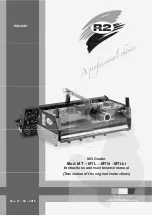
Installing and Configuring the RangeGuard System
10
Where to Mount the Sensors
Application
Typical Sensor positions
Obstacle detection
Two wide beam sensors pointing towards the area of expected obstacles.
Position lockdown while station keeping
Single sensor (wide or narrow beam) pointed towards the reference position. Change in position
monitored manually.
Bridge collision warning
Wide beam sensor mounted on the bridge roof or as required.
Clearance warning and monitoring
Two wide beam sensors pointing towards the area of expected obstacles.
Asset protection
Wide and narrow beam sensors mounted as required to warn of area intrusion.
Vessel protection (drive-off detection)
Wide beam sensors integrated into the vessel structure.
Offshore supply vessel station keeping
Minimum of two wide beam sensors reporting range.
Wind farm dynamic positioning
Two wide beam sensors mounted on the operations side of the vessel with a maximum separation
of 20m.
Salvage (monitoring athwart speed and
during fender operations)
Narrow beam sensor horizontally mounted between fenders and adjacent to the centreline of the
vessel.
Berthing aid
Horizontally stern and shoulder mounted and adjacent to the centreline of the vessel.
Blind spot detection
Wide beam sensor covering the blind spot.
Blind Spot Augmentation (when used with
video)
Single wide beam sensor pointing towards the area the video is monitoring.
Ship-to-Ship (LNG) transfer (athwart speed
and distance detection)
Narrow beam sensors mounted at the stern and the shoulder of the follow vessel.
Autonomous Vessel applications
Sensors mounted around the perimeter of the vessel for local proximity hazard detection.
Training Aid
Used to confirm distance estimates of crew during close operations; narrow beam sensors
mounted as required.
Содержание 20-0183-1
Страница 1: ... 1 ...











































